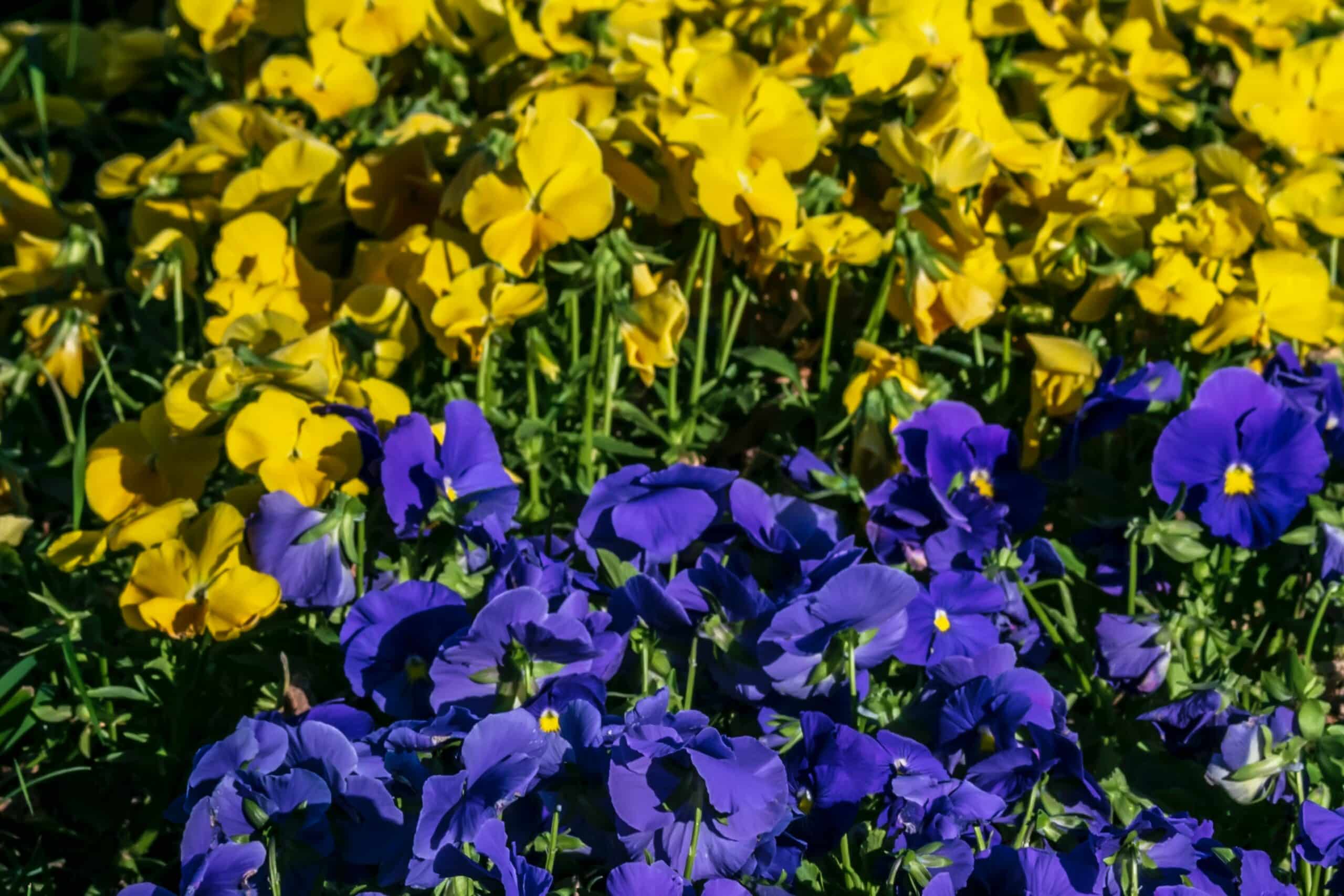Beauty is often found in the simplest of things. Such is the case with violas, a flower that has been delighting gardeners for centuries. These delicate blooms provide an abundance of vibrant color and texture to any outdoor space, making them a delightful addition to any landscape. With proper care and knowledge, one can enjoy these beautiful flowers year-round. This guide will provide you with all the information you need to keep your violas healthy and thriving!
Violas are among the most popular flowering plants in gardens around the world. They come in a wide range of colors including blue, purple, yellow, white and pink. Their small size makes them perfect for filling in gaps between other larger plants or used as edging along pathways or driveways. These charming little flowers are also incredibly hardy and can survive even through cold winters if given the right nutrients and protection from wind and frost.
Whether you’re a novice gardener or experienced green thumb, learning how to properly care for violas is essential for keeping them looking their best throughout the season. With this guide, we’ll explore everything from planting and watering tips to fertilizing techniques so that your viola plants can thrive in whatever climate you have!
Choosing The Right Viola Variety
Violas are popular flowering plants that come in a variety of colors and sizes. When selecting the right variety for your garden, it’s important to consider factors like climate, soil type, and final intended use. With a little research and knowledge of your growing environment, you can ensure you make the best choice for a beautiful display.
First off, decide whether you’d like to grow annual or perennial violas. Annuals last just one season and will die off when winter begins. Perennials will survive for two or more seasons if provided with proper care during colder months. If you live in an area with cold winters, perennials may be the better option since they can withstand more extreme temperatures.
Next, determine the type of soil and climate conditions that are present in your garden space so you can choose varieties that are well-suited to them. There are some varieties available specifically designed for hotter climates while others thrive in cooler temperatures. Additionally, make sure that your soil is well-draining, as some viola varieties don’t tolerate standing water very well.
Once you’ve determined what kind of violas would do best in your garden space, it’s time to move on to choosing where to plant them! Make sure that whatever spot you choose gets plenty of sunlight throughout the day; this will give your plants their best chance at thriving and producing plenty of blooms all season long.
Where To Plant Violas
Planting your Violas in the right spot is key to getting them to thrive. Where you plant them will determine how successful they are in your garden, so it’s important to understand the requirements for each variety.
There are a few things to consider when choosing where to plant your violas:
- Sunlight: Violas need at least 4-6 hours of sunlight per day, but some varieties need more or less depending on their growing conditions.
- Soil: Make sure the soil you choose has good drainage and is well aerated so that water doesn’t pool around the roots of your plants.
- Temperature: Some viola varieties can handle colder temperatures than others, so be sure to check the ideal temperature range for each variety before planting.
- Exposure: If you live in an area that gets very windy, make sure you provide protection from the wind by planting your violas in an area with shelter or by using stakes or other supports.
When it comes time to plant your violas, think about these factors and be sure to choose a spot that meets all their needs. This way, you’ll give them the best chance at thriving and giving you years of beautiful blooms!
Having chosen where to plant your violas, now it’s time to look into what type of soil they need for optimal growth and health.
Soil Requirements For Violas
Soil requirements for violas are an important factor for a successful and healthy plant. For the best results, you’ll want to ensure that your soil provides them with the necessary nutrients and drainage. Let’s explore what these needs are so you can create the perfect environment for your violas.
When it comes to soil, violas need a blend of organic material and soil that is well-draining. This will provide adequate air circulation and water drainage. If you’re planting in pots or containers, use a potting mix specifically designed for flowers as opposed to plain garden soil. Additionally, if planting in beds, be sure to mix in some compost or aged manure; this will help provide the violas with important nutrients they need to thrive.
It’s also important that you don’t over-fertilize – too much nutrient-rich fertilizer can actually cause more harm than good! Violas prefer a slightly acidic pH between 5.5 – 6.5; however, they are relatively tolerant of a wide range of acidity levels in the soil. With all this in mind, you can be sure that your plants will have exactly what they need when it comes to their soil requirements.
Now that we’ve looked into the appropriate soil conditions for your violas, let’s move on to discuss light requirements for these beautiful flowers...
Light Requirements For Violas
Light is an essential element for success when growing violas, just like the sun is vital for humans to thrive. It’s time to understand how to provide your flowers with the ideal light conditions, so they can have a blooming season that leaves everyone in awe.
Here are three things you should know about light requirements for violas:
- Light Intensity:
- Direct Sunlight: Violas need 6-10 hours of direct sunlight a day in order to bloom properly. If you have full sun, then it’s best to partially shade them during the hottest part of the day.
- Partial Shade: If you don’t have full sun, then partial shade is fine. They will still bloom well and remain healthy in bright indirect light or a few hours of direct sunlight each day.
- Full Shade: Too much shade can be harmful for violas and inhibit their growth. You may not get any blooms if your plants are in full shade all the time.
- Temperature Requirements: Violas enjoy cool temperatures between 45°F and 75°F (7°C – 24°C). Anything cooler or warmer than this range may cause damage or prevent them from flowering as much as they should.
- Humidity Levels: The humidity level should remain moderate to high levels at all times. This will help keep the soil moist and prevent wilting or yellowing of the petals due to stress from dry air conditions.
Providing your violas with proper lighting can make all the difference when it comes to having beautiful blooms throughout the season. With these tips in mind, you’ll be able to find just the right place for your flowers that offers them enough light while protecting them from extreme temperatures and humidity levels. Now let’s move on to watering…
Watering Violas
Watering violas is like painting a picture. Too much or too little water can ruin the composition. To keep them thriving, here are 3 tips on watering your viola plants:
First, water deeply, but infrequently. Violas don’t appreciate soggy soil, so allow the top several inches of soil to dry out before you water again. Secondly, if it’s been especially hot and dry, give your violas some extra love with a good soak. This will help them retain moisture and stay healthy during droughts. Lastly, keep an eye on the amount of sunlight they’re receiving – young violas need more frequent watering than mature ones in order to survive.
When it comes to watering your viola plants, it’s all about striking the perfect balance between underwatering and overwatering. Remember: too much or too little water can be detrimental to their health. To ensure that your viola plants get just the right amount of hydration, take special care when choosing their potting soil, checking for adequate drainage and only giving them enough water when necessary. With these tips in mind, you’ll have a beautiful garden full of happy and healthy violas!
Feeding Violas
Feeding your violas is an important part of their care and will help them thrive. The best way to feed your violas is with a balanced liquid fertilizer that’s diluted to half the manufacturer’s strength. This should be done every two weeks while they are actively growing.
For maximum bloom, you can also add a fertilizer specifically designed for flowering plants to the soil when planting. Once the flowers start blooming, you can give additional fertilizer every couple of weeks to ensure the flowers stay vibrant and healthy.
It’s important to avoid overfeeding your violas because this can cause them to become leggy and have fewer blooms. Instead, provide just enough fertilizer so they get all the nutrients they need without damaging their delicate roots or foliage. With proper feeding, your violas will be blooming in no time!
Next up: mulching your violas for healthier growth!
Mulching Violas
Mulching your violas is like giving them a warm hug – it helps keep the soil moist and gives them an extra layer of protection against weeds. It’s an essential step in keeping your plants healthy and flourishing. Here are the top 3 ways to mulch your violas:
Start with a thick layer of organic material, such as wood chips or compost. This will help keep the soil temperature consistent and block out sunlight if you’re growing in a sunny spot.
When applying mulch, be sure to leave some space around each plant’s stem so that it can still get plenty of air circulation.
Water your violas regularly, but don’t overwater them – too much water can cause root rot and other problems.
Mulching is one of the best ways to ensure that your violas stay healthy and thriving all season long. By providing this extra layer of protection and helping regulate the moisture levels in the soil, you can encourage beautiful blooms for months to come! To keep your plants looking their best, it’s also important to properly deadhead them once they’ve finished blooming…
Deadheading Violas
Deadheading violas is a great way to keep the blooms coming and keep your garden looking neat and tidy. It’s like putting icing on the cake – you know it’s gonna be good, so why not make it look even better? Deadheading involves removing spent flowers and flower stems from plants to encourage new growth and reduce the plant’s energy expenditure.
This practice is especially important for violas because they tend to produce more flowers when deadheaded regularly. When you deadhead, start by cutting off any dead or wilted flowers at their base. Then, trim off any old or fading stems that are still attached to the plant. This will help promote new growth. Be sure to use sharp pruners for a clean cut and avoid damaging the foliage or stems of the plant.
When deadheading violas, take care not to accidentally remove buds that have yet to open – this could delay flowering time. Additionally, if there are seed capsules present, leave them in place so that they can provide food for local wildlife during the winter months. With regular pruning, your violas will continue to look their best throughout the growing season!
Staking And Supporting Violas
Once your violas are blooming and looking lively, you may need to consider how to provide them with the best support. Staking and supporting the plants is essential if they are not in a location that provides self-support like a hanging basket or raised bed.
Staking can help keep the stems upright, which helps prevent breakage due to winds or heavy buds. Wooden stakes or bamboo canes work well for this purpose. Place them at least six inches away from the center of the plant and secure them firmly with wire ties or twine. This will provide necessary stability for your flowers without damaging the roots.
Supporting violas can also be done by growing them next to other sturdy plants that will act as natural support systems; tall grasses, ornamental grasses, shrubs, and trees are all good options for this purpose. To get maximum benefit from these supports, be sure to prune any plants that are blocking sunlight from reaching your violas. By providing proper staking and support for your plants, you’ll ensure their flowers remain upright and vibrant all season long!
Controlling Pests And Diseases
While we all want our beautiful violas to thrive, there is always the possibility of pests and diseases that can jeopardize their health. But no need to worry, with proper care and maintenance, it’s easy to keep your violas healthy and safe.
Controlling pests and diseases doesn’t have to be complicated or difficult. Most of the time, if you detect a pest or disease early enough, you can take preventative measures before things get out of hand. Keep an eye out for aphids, caterpillars, slugs, and snails – all of which can cause damage to your plants. To protect against these pests you should use non-toxic insecticides such as neem oil or diatomaceous earth.
If you come across any signs of disease in your violas such as rot or mildew, remove affected areas immediately. You should also take care to ensure that your plants are getting enough air circulation by spacing them properly and keeping them away from shady spots. Finally, make sure that your soil is free draining so that excess moisture doesn’t accumulate around the roots – this will help reduce the chance of fungal infection.
With these steps in mind, you’ll be well on your way to creating a thriving environment for your beautiful violas! As winter approaches however, there are some additional considerations when it comes to overwintering your violas – but more on that later!
Overwintering Violas
It’s important to protect your violas over the winter months. If you live in a cold climate, it’s critical to ensure that your violas have a good chance of surviving the winter and returning in all their glory the following year. In this article, we’ll discuss how to overwinter violas and give you tips on keeping them healthy through the colder months.
When temperatures start to drop in autumn, it’s time to think about protecting your violas from frost and other weather damage. Move any container-grown plants indoors, or cover them with a tarp or mulch if they’re planted in the ground. Once they’re inside, make sure they get plenty of light, as well as humidity and air circulation. It’s also important to keep an eye out for pests, as these can be more active during winter when it’s colder outside.
If you’ve done your best to keep your violas safe and warm over winter, then you should be rewarded with beautiful blooms come springtime! With proper care and attention throughout the colder months, you can look forward to seeing vibrant flowers again next year – take the time now and reap the rewards later!
It’s not just surviving winter that will guarantee success – propagating violas is also key for ensuring that they thrive long-term. Next up, we’ll look at what steps you need to take for successful propagation...
Propagating Violas
Propagating violas is like planting a seed of potential: you can watch it grow and flourish into something beautiful. With the right care, violas can be spread throughout your garden, offering an array of colors and textures. Here are some tips to help you get started:
• Start with healthy plants. Look for robust, healthy stems that have no signs of disease or pests. • Consider division or cuttings. If you’re looking for an easy way to propagate your violas, try dividing the rootball or taking cuttings from your current plant. • Provide plenty of light and moisture. Make sure your new plants get enough sunlight and water during their growing period to ensure a strong, healthy start. • Be patient! Propagating violas can take some time; allow a few weeks for the process to be completed before harvesting them.
Overall, propagating violas is an easy yet rewarding task that ensures they will thrive in their new environment. With these steps in mind and the right conditions, you’ll have new plants blooming before you know it – no green thumb required! Now, let’s move on to learning how to harvest them…
Harvesting Violas
Harvesting violas is a great way to enjoy the fruits of your labor and get the most out of your plants. It’s also an important part of keeping them healthy and ensuring their longevity. In this section, we’ll cover what you need to know about when and how to harvest these lovely flowers.
First, it’s important to understand when it’s time to start picking. Violas are typically ready for harvest about four weeks after planting, or roughly when the flowers have fully bloomed. If you wait too long after blooming, the petals will begin to lose their vibrant colors, which can significantly reduce their value as cut flowers. Therefore, timing is essential if you want to make sure your violas reach their peak beauty in bouquets!
To ensure that you get the best possible results from your harvesting efforts, there are a few tips and techniques that can help. First off, always use scissors or shears so that you don’t damage the stem or leaves. Additionally, try cutting just above where two leaves meet so that more branches can grow from that point later on. Finally, avoid working with wet stems as much as possible since they’re more likely to suffer from rot and infection.
By following these simple tips and understanding when it’s time to start harvesting your violas, you’ll be able to maximize their value for yourself or others who may be purchasing them for bouquets or other arrangements. Now let’s look at how companion planting can help improve their health even further for years of enjoyment!
Companion Planting For Violas
Gardening with companion plants can help to create a vibrant and healthy garden ecosystem, and violas are no exception. According to research, companion planting can increase yields by up to 20%. So if you want your viola patch to thrive, then it’s worth considering what other plants could be planted alongside them.
Companion planting involves selecting plants that benefit each other when grown together. For example, certain plants act as “trap crops” that attract pests away from the main crop. Others provide natural pest control or act as nitrogen fixers that enrich the soil. Still others offer protection from wind and sun or provide important shade to keep the soil cool in hot climates.
When growing violas, some great companion plants include roses, foxgloves, petunias, ferns and sweet alyssum. Not only do these plants look beautiful when planted together, but they also offer a variety of benefits for your viola patch. Roses provide shade and may even help deter pests from attacking the flowers, while foxgloves add a burst of colour and attract pollinators like bees and butterflies. Petunias also attract pollinators while their strong scent helps repel harmful insects. Ferns act as an attractive ground cover and sweet alyssum helps trap harmful nematodes in the soil around your violas – making them a great choice for any garden!
With the right companion plants in place, you can create an attractive garden environment that will help your violas flourish – so why not give it a try?
Troubleshooting Common Viola Issues
Though they bring a burst of color to any garden, violas can be tricky to manage. As such, many gardeners find themselves troubleshooting common issues that arise with these beautiful flowers. Fortunately, there are a few simple steps you can take to help ensure your violas remain healthy and happy.
In the modern age of convenience, it’s easy to forget the importance of preventative maintenance when it comes to gardening. To ensure your violas stay in good shape, regularly check for pests and disease and remove any dead or damaged foliage. Additionally, make sure the soil has enough nutrients and water for optimal growth, as well as sufficient drainage to avoid pooling water around the roots.
One of the most common problems experienced with violas is poor air circulation. If your plants aren’t getting enough air flow, their growth will be stunted and they may even succumb to mildew or other fungal diseases. Make sure there is plenty of space between each plant so that air can circulate freely. Additionally, avoid planting too close together so that more light can reach each individual flower.
By following these simple tips, you’ll be able to keep your viola plants looking their best without having to worry about common stressors that come with gardening. With some dedication and consistent care, you will soon see your violas blooming in all their glory!
Frequently Asked Questions
How Often Should I Water My Violas?
Watering your violas can be as soothing as a refreshing summer breeze. Just like any other plant, your violas need the right amount of water to stay healthy and happy. But how often should you water them?
The answer depends on what kind of soil your violas are planted in and the climate in which they are growing. Generally speaking, it’s best to water your violas when the top few inches of soil are dry. Doing this will help prevent overwatering, which can cause root rot or other diseases.
To make sure that your violas have enough moisture, test the soil with your fingers before watering. If the soil feels dry, then it’s time to give them a drink! You may also want to consider using a drip irrigation system or soaker hoses to maintain an even moisture level for your plants.
By providing adequate water and consistent care, you’ll be rewarded with beautiful blooms from season to season. Remember, healthy plants make for happy gardeners!
Is There A Best Time Of Year To Plant Violas?
Do you have a place in your garden that could brighten up with the beauty of violas? If so, it’s important to consider the best time of year to plant them. While violas are hardy plants that can survive many climates, there are certain seasons that are more conducive to their healthy growth and flowering.
The cooler months from October through March are ideal for planting or repotting any type of viola. This will give them enough time to establish themselves before having to endure extreme weather conditions in the summertime. They should also be planted in well-draining soil and mulched lightly after planting.
It’s also important to keep an eye on the watering needs of your violas—depending on how much rain you get, they may require extra water during dry spells. A slow and deep soaking once a week is usually enough, but if rainfall is scarce they may need more frequent watering. If done properly, violas can add a burst of color and vitality to your garden all year round!
Is There An Easy Way To Propagate Violas?
Propagating violas can be a great way to get more of these colorful flowers in your garden quickly. Not only is it easy, but it’s also a lot of fun. Here’s what you need to know to get started.
First, decide whether you want to propagate with seeds or stem cuttings. Both methods are simple and successful, so the choice is yours! Seeds will take longer to germinate and then grow, while cuttings will give you blooms much faster — usually within a few weeks.
Whichever method you choose, make sure you prepare the soil with plenty of compost first. And don’t forget that violas enjoy partial shade, which helps them thrive even during hot summer days. With just a bit of extra care and attention, your viola propagation efforts will be rewarded with beautiful blooms all season long!
Are There Any Other Plants I Should Consider Planting With My Violas?
If you’re looking for a companion plant to pair with your violas, you won’t be disappointed. There are many options that can bring out the best in your viola garden!
From annuals to perennials, you can find the perfect plant to bring texture, height and color to your garden. Here are some great companion plants to consider:
• Pansies – Pansies love cool temperatures and provide a beautiful contrast with their bright colors. • Marigolds – Marigolds have strong roots that help keep weeds away from your violas. Plus, they make a great border for any flower bed! • Alyssum – Alyssum’s sweet scent will attract pollinators like bees and butterflies. They also make lovely ground covers. • Petunias – Petunias come in a variety of sizes and colors, making them perfect for filling in any gaps in your viola garden. • Calibrachoa – Calibrachoa is an easy-to-care-for annual that blooms profusely throughout the summer months and adds vibrant color to any outdoor space.
Whether you’re looking for something low maintenance or something that provides lots of color and texture, there’s a companion plant out there that will work perfectly with your violas. Take some time to research different varieties and see which ones speak to you – it’ll be worth it when you see how beautiful the combination of plants looks together!
Can I Grow Violas Indoors?
Irony can be a powerful tool, and when it comes to growing plants, it’s no different. Growing violas indoors? It may sound like an almost impossible task at first, but with the right care and attention, it’s more than doable.
When considering whether or not to grow violas indoors, there are certain factors to consider. Is the space large enough for the plant to thrive? What kind of soil does your plant require? How much light does it need? All of these questions will help you determine if violas are a good fit for your indoor garden.
Fortunately, violas are relatively easy plants to keep alive inside the home. They don’t require a lot of light or soil changes – they just need good drainage and regular watering. With some patience and dedication, you can create a beautiful oasis in your home with these cheerful flowers. Plus, their vibrant colors will add a pop of color to any room! So if you’re looking for an easy-to-care-for plant that adds life and beauty to your home, violas might be just what you need.
Conclusion
The viola is a beautiful flower that can not only be grown outdoors, but also indoors. It is a small, delicate bloom that can add a touch of elegance to any garden or home. Despite its beauty and resilience, many people find themselves intimidated by the care and maintenance required to ensure their violas thrive. Fortunately, with the right knowledge and attention, growing and caring for these flowers is actually quite simple.
For those who are looking for an easy way to brighten up their home or garden, violas are an ideal choice. With proper watering and planting techniques, they will bring joy to any space in no time. While some might be frustrated by the extra effort required to ensure their success, it’s important to remember that the reward of being able to enjoy the beautiful blooms more than makes up for it.
Growing violas isn’t just about having attractive flowers; it’s also about finding joy in taking on a challenge and succeeding. When done correctly, there will be nothing more satisfying than seeing your hard work come together in the form of vibrant blooms around your home or garden. It’s a reminder that even something as seemingly difficult as taking care of violas can be surprisingly rewarding when done properly.





























